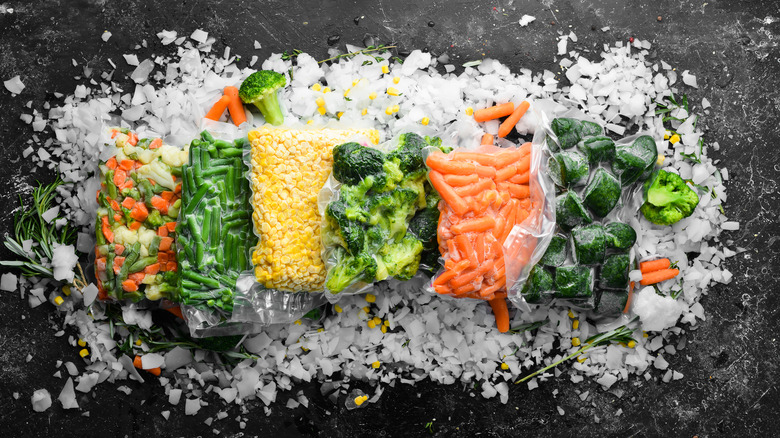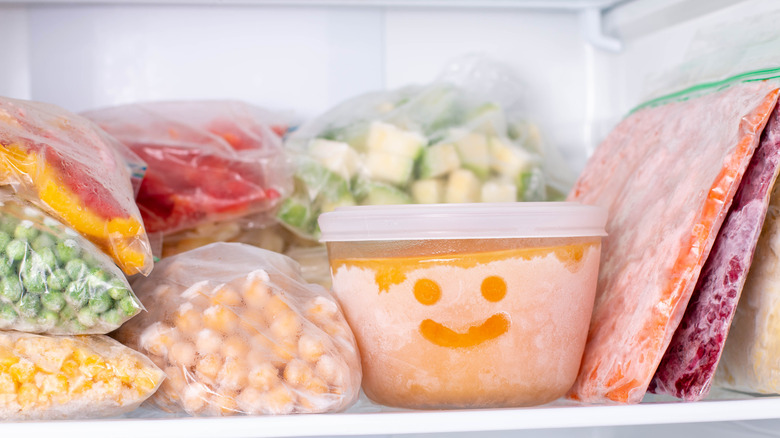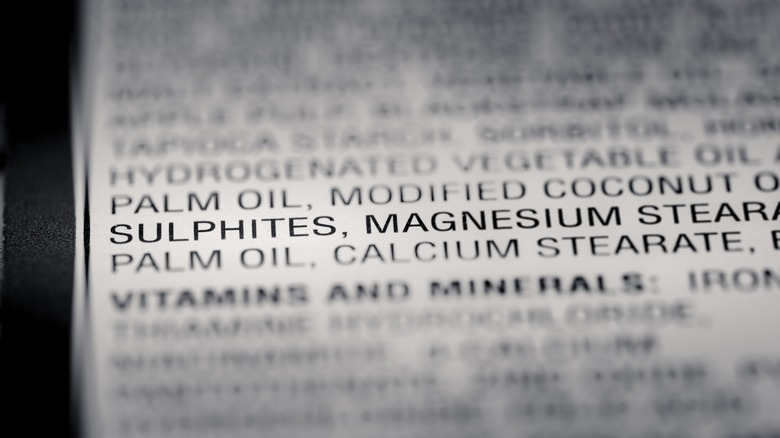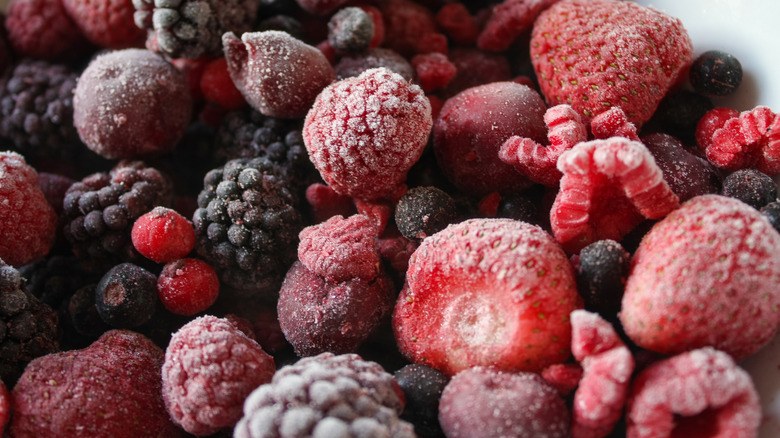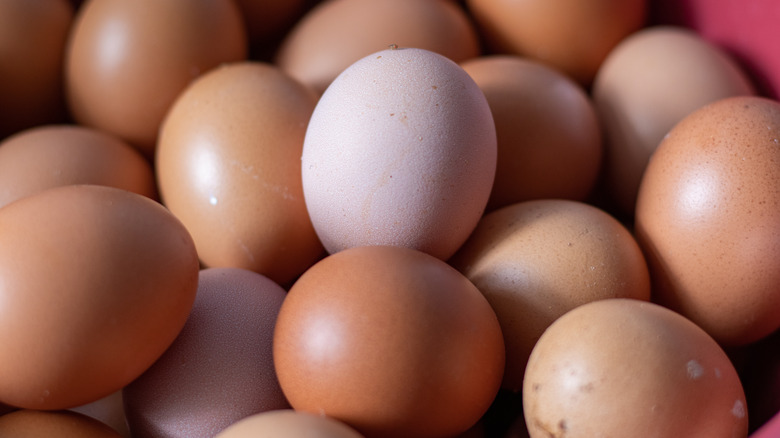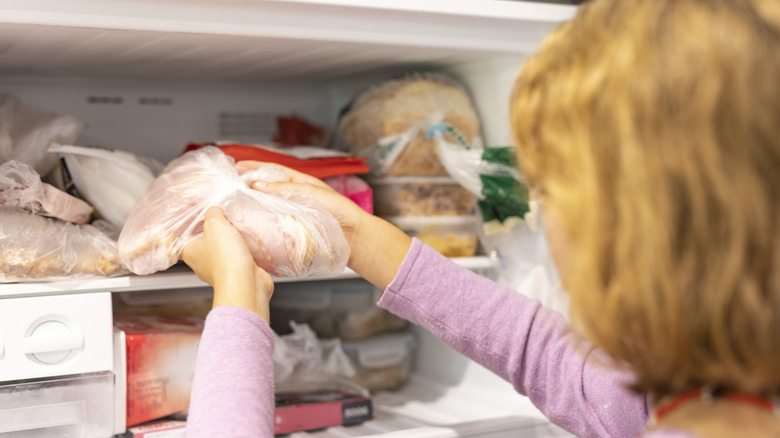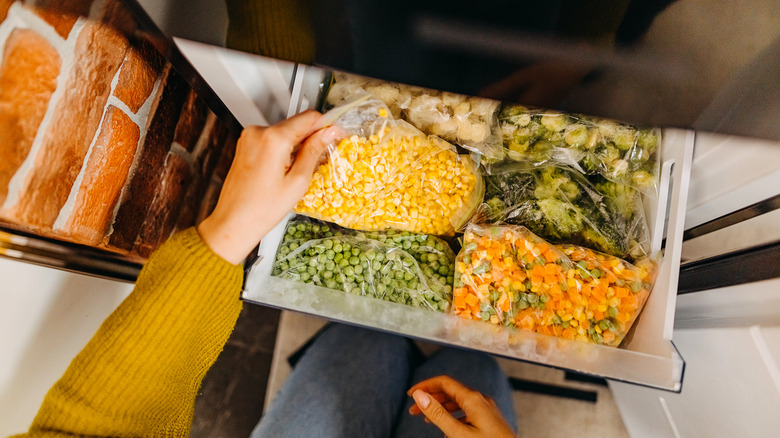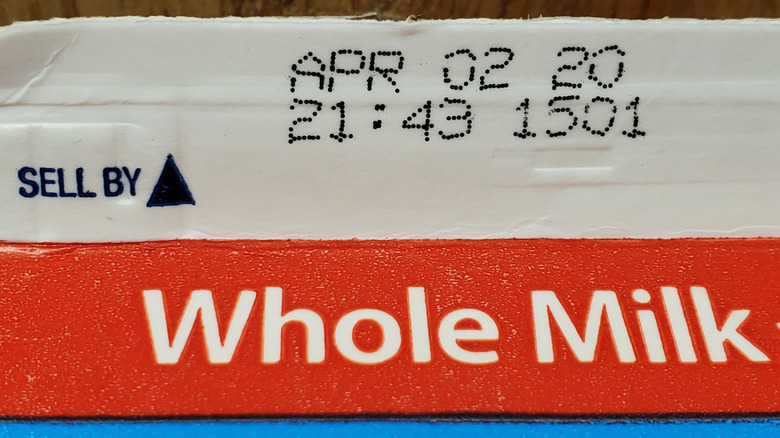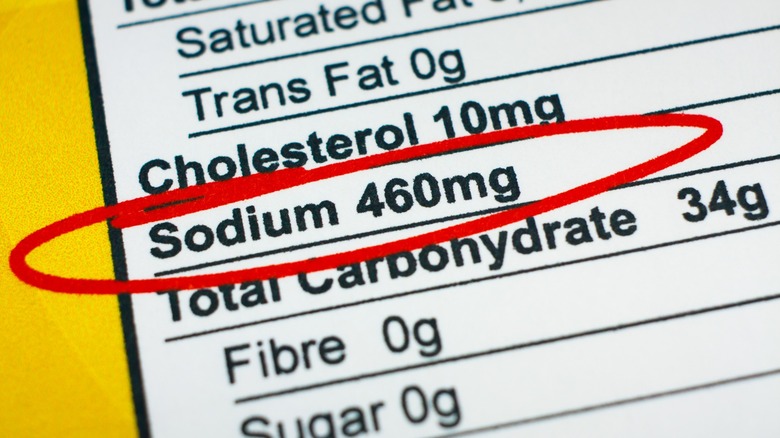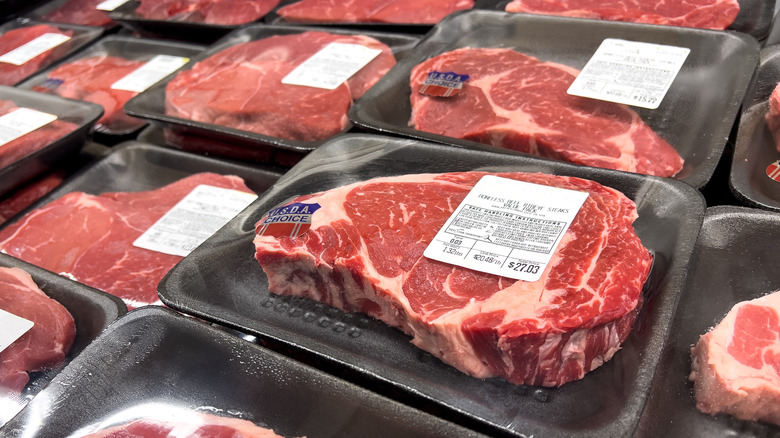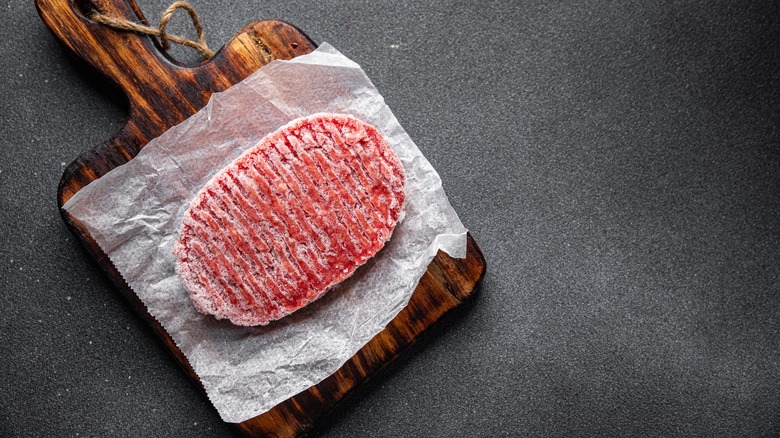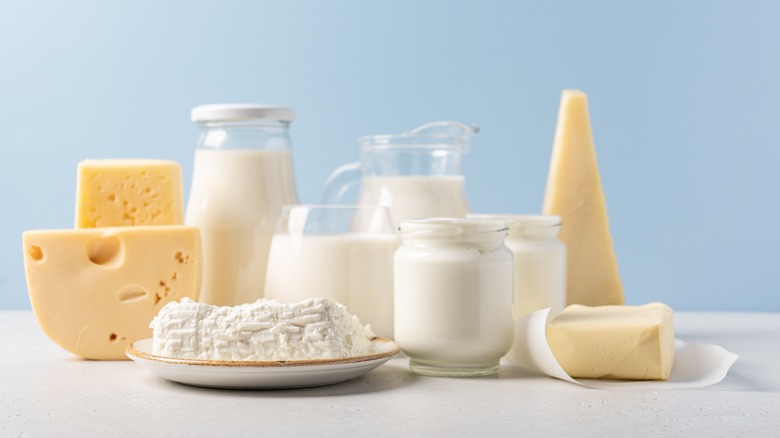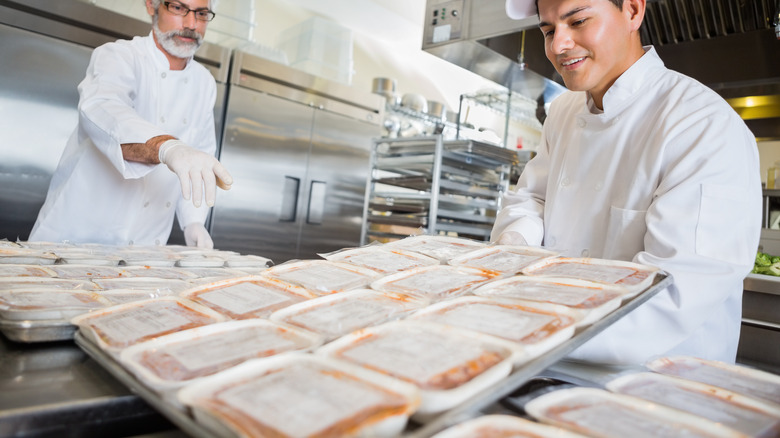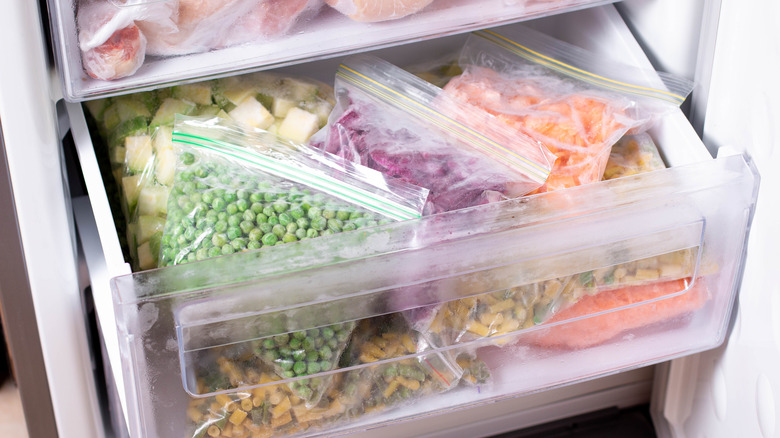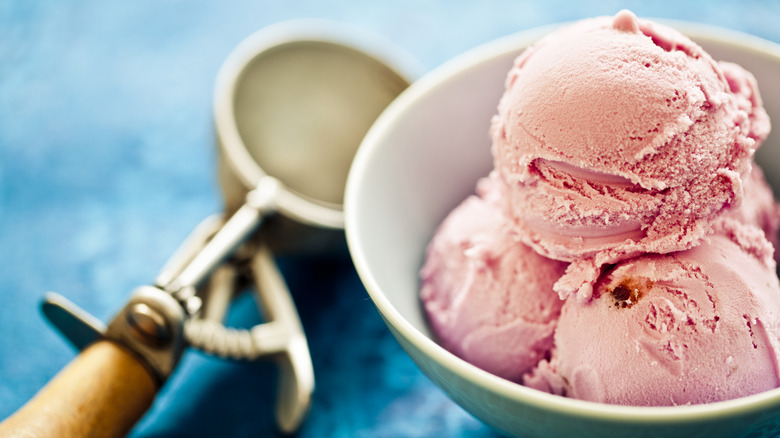14 Frozen Food Myths You Should Stop Believing
It's hard to believe, but there was once a time when if you wanted to eat something, you had to act quickly: If you were lucky, your fresh food lasted a few days before it needed to be thrown out. But then, refrigeration, freezers, and frozen food were invented, and everything changed.
The quick-freezing method, invented in 1924 by Clarence Birdseye, opened up a world of food to consumers living in all kinds of climates. With the creation of industrially-frozen food, you no longer had to live in a chilly part of the country to make your items last. You could simply fish your items out of the deep freeze in the store, trusting that the flash-freezing process would help it avoid the creation of ice crystals that would deteriorate the food, and keep it at sub-zero temperatures for months to come.
However, this new-fangled technology didn't come without doubts. To this day, people still believe some common misconceptions about frozen food, like that it's lower quality than fresh food items, or more expensive for a lesser product. Some folks also assume that certain foods can't be frozen when they absolutely can, or that other foods can be thrown in the freezer with little preparation. All of these myths and more are about to be put right.
1. Myth: Frozen food is not as healthy as fresh food
Somewhere along frozen food's journey, people started to believe that it was unhealthier than fresh versions of the same item — and this myth stuck. This perhaps stems from the assumption that frozen food somehow loses its nutritional quality as processed and frozen. Luckily, though, this generally isn't true. Frozen produce like fruits and vegetables are processed and flash-frozen very quickly, often within hours of being picked at their ripest, with the intention being to capture that freshness as quickly as possible. The result is that their nutrient levels are frozen, too, meaning that when you defrost them, they're as wholesome as they were when fresh.
It may even be that frozen food items are healthier than fresh foods that have been sitting around for a few days, losing their nutrients and developing a duller flavor. There are exceptions to this healthiness, however. There are some pretty grim frozen food options out there, including unhealthy frozen meals from producers like Lean Cuisine. Some of these frozen foods are highly processed, high in sodium and sugar, and are decidedly not healthy.
2. Myth: All frozen foods contain preservatives
Frozen foods, particularly frozen meals, often get a lot of attention for their ingredients — and how they stay so fresh for so long. This attention, and the presence of some additive-containing frozen food options, has led some people to believe that frozen foods all contain preservatives. That's not the case, though. Frozen foods are often preservative-free, simply because they don't need them. Freezing food to a super-cold temperature reduces its microorganism activity, thereby allowing it to stay preserved without any additional ingredients. As such, on ingredient lists for items like frozen vegetables, you'll often just see the vegetable itself with nothing added. Pretty comforting, right?
If you're thinking "Sure, but what about frozen meals?" though, we've got a nice surprise for you: They often don't have preservatives either. Some popular options out there, like Stouffer's Lasagna with Meat & Sauce, are preservative-free. Again, because these meals are frozen quickly and kept at a low temperature, they don't need the extra help — unlike foods designed to be shelf-stable at room temperature, which often have preservatives.
3. Myth: When food is frozen, it loses quality
If you've ever picked up a bag of frozen vegetables and found them to be disintegrated, mushy, and lacking in flavor, we do feel for you — but that doesn't mean that all frozen food is the same. Commercial frozen food processes are highly refined to keep as much quality in the product as possible. When food is flash frozen in industrial freezers (which can reach temperatures of -40 degrees Celsius), it only develops small ice crystals on its surface, in contrast to the bigger ice crystals that occur when food is frozen slowly. This ultra-quick freezing process, and the tiny ice crystals that form, prevent the food from losing texture, flavor, or nutritional value.
Unfortunately, while food may not lose its quality when frozen commercially, it may lose its quality over time. It's commonly assumed that frozen food will remain suspended in ice without changing forever, but enzymatic reactions can still occur, even at super-low temperatures. This enzyme activity can lead to your food breaking down, and so while it may happen much slower than at room temperature, frozen food does still degrade over time.
4. Myth: Most foods can't be frozen
We tend to use our freezers for very specific foods: Bags of produce, frozen meals, and meat or fish. Because of the popularity of these items, it's very easy to fall into the trap of believing that most other foods are unsuitable for freezing. This couldn't be further from the truth. Pretty much anything can be frozen if you put your mind to it, and provided that you package it correctly.
Eggs, for example, can be frozen in many different ways, and this can allow you to make a batch of premium eggs last way longer. Although you probably shouldn't freeze them in their shells, cracking them into a container and sealing them can make them last for months. Freezing is one of the best storage methods for keeping nuts fresh, too, thanks to freezing's ability to prevent rancidity. There are also a lot of frozen foods that last a surprisingly long time that you might not expect can be placed in the deep freeze. Try popping your coffee beans or chicken stock in the freezer: Doing so can help them last months longer than they would if stored in other ways.
5. Myth: Thawed frozen food can't be refrozen
There's often a "one-time-only" mentality around freezing foods. The thought is that if you've thawed your items, they can't be refrozen. Well, folks, they can. It's safe to refreeze food that's been thawed, and provided that they haven't started to go bad, they'll be fine to eat the next time you want them.
It's worth remembering, however, that while it may be safe, it may not be very appetizing. Frozen foods tend to lose a lot of their quality when they're refrozen, and their texture in particular can be altered beyond redemption. This is often an issue when it comes to frozen vegetables, which take on a lot of water and become mushy when refrozen and re-thawed, and ice cream, which loses its air content when it's melted and turns hard when refrozen.
A smart way to get around this is to use these thawed items in recipes that you can then freeze. Once your frozen vegetables have thawed, throw them into a stew or a curry — and then freeze the leftovers. The vegetables may still change in texture, but they'll be less noticeable thanks to the other ingredients and flavors.
6. Myth: Frozen food is more expensive than fresh food
As a general rule of thumb, the more processed a food item is, the more it will cost. The increased price reflects the labor it took to make it, the added ingredients, and the convenience of not having to rustle it up yourself. Frozen foods, however, are a bit different. Frozen foods can often be pretty much the same price as their fresh counterparts, and in some cases, they may be even cheaper. This is often the case with frozen fresh produce, as the fact that they are frozen means that they don't need to be transported quite so quickly, reducing their cost.
With other food items, however, things aren't quite as simple, and frozen options may be more expensive than others, or climb in price more quickly. In 2022, for instance, frozen meat grew in price by almost 30%, whereas fresh meat was subject to just a 5% increase (per Numerator). It's also important to remember that frozen foods tend not to be subject to the same price reductions that fresh foods often are, especially at the end of the trading day when stock needs to be cleared.
7. Myth: You can't freeze food that's past its sell-by date
Sell-by dates on food remain kind of a gray area. While the date itself is often clear, what that date means for your food safety is often less clear, especially if you're planning on freezing your items. The good news is that the assumption that you can't freeze food that's past its sell-by date is a myth, because a sell-by date doesn't indicate that your food has gone bad and is inedible.
"Sell-by" dates, as well as "freeze-by" dates, are not printed for food safety. Instead, they're placed on products to indicate when a store should sell the item to manage its stock rotations, and when the item will be past its peak freshness for freezing purposes. "Best if used by" and "use-by" dates are also intended to show when your food has passed its peak, not when it's unsafe to eat. You can therefore feasibly freeze items past all of these dates and still have them be safe for consumption when defrosting. What you should instead watch out for is signs of spoilage, like changed textures, funky smells, or mold growth. These signs indicate that your food should be thrown away instead of frozen.
8. Myth: Frozen food is always high in sodium
Sodium is an unfortunately common feature of many frozen foods. Commercially produced frozen meals, in particular, are sometimes loaded with sodium, both as a way to boost their flavor and as a tactic to keep the food preserved and fresh for longer. Some frozen foods you'd never expect to be loaded with salt are also surprisingly high in sodium, with frozen chicken strips sometimes containing an unreasonable amount of the ingredient.
However, the claim that frozen food is always high in sodium is completely false. There's a massive variety of frozen meals out there that cater to every taste and dietary requirement, and a vast range of low-sodium options. Producers like Amy's Kitchen, Healthy Choice, and Sweet Earth have good selections of low-sodium frozen meals that are also often wholesome in other ways, omitting artificial ingredients or using organic produce for their offerings. More simple frozen ingredients, like bags of frozen veggies, are also usually sodium-free unless otherwise stated. It's generally good practice, though, to always check the nutritional label of anything you're buying, just in case it's snuck in there somewhere.
9. Myth: You can put food straight in the freezer in its original packaging
Getting food ready to be frozen is one of those annoying jobs that most people don't want to do. So it makes sense that at some point, someone probably just flat-out lied to save themselves time, and made the wild claim that food doesn't need to be prepped at all — it can just be thrown in the freezer in its original packaging.
Well, while that might be true for some items, it's not true for others. Meat and poultry are a good example of this. While you can technically freeze meat and poultry in their original packaging, the wrapping they are placed in by your supermarket isn't air-resistant, and will allow the cold air in your freezer to come in contact with the produce. This will lead to your items deteriorating faster than you'd probably like, developing freezer burn, and needing to be thrown out.
So, you should always make sure your food is as well-wrapped as possible before freezing it, to limit contact with the air. Wrap your items in freezer wrap or thick foil, and then place them inside an airtight Tupperware container or freezer bag. The double protection will prevent any air from getting to your items and will keep them tasty and nutritious for longer.
10. Myth: Frozen food isn't as flavorful as fresh food
For us, flavor is the most important aspect of basically any food, and we're constantly on the hunt for produce with the best taste. This produce doesn't have to always be fresh, though. Many people think that frozen food has a duller flavor than fresh food and that somehow, the freezing process makes their taste less intense.
This simply isn't true. Instead, the flavor of your food comes down to how good it was in the first place. "Concerning taste, as with any food, this is dependent on the quality of the food and its preparation," Nomad Foods' Group Nutrition Leader Lauren Woodley told The Sun. Quite simply, if food is delicious before it's frozen, it'll be delicious after it's frozen, too.
So where does this belief come from? Woodley has some thoughts: "One of the sources of the myth that frozen food loses its flavour is people's experience of improperly frozen food, or food that's partially defrosted before re-freezing." Thawing and refreezing food can cause it to lose its original texture and flavor, thereby making it less appetizing. Food that's developed freezer burn can also have a diminished taste. High-quality, well-frozen food, however, will be just as tasty as fresh food.
11. Myth: You can't freeze dairy products
Most people are comfortable with freezing a host of items, but when it comes to dairy products, they start to worry. To be fair to these folks, we understand why. Dairy products are notorious for separating when frozen and thawed, with the dairy fats pulling away from the water and turning into a gritty, coagulated mass of solids. This is a particular problem with full-fat milk.
It's a myth, though, that all dairy products can't be frozen. The trick is to make sure that the item's ratio of fat to water is correct. Low and non-fat milk, for instance, can usually be frozen without any issues, and when thawed will stay just as smooth and incorporated. Cream, on the other hand, can be frozen when it has a high quantity of butterfat (40% or more), but when it's lighter it will be more likely to separate.
Butter, meanwhile, is very capable of being frozen, particularly flavored butter. Cream cheese and hard cheeses can also be frozen, although you might find that the latter loses its texture slightly upon being thawed. It's important to remember that different dairy brands have different formulations and fat levels for their products, though, so it's best to treat your items on a case-by-case basis.
12. Myth: Frozen food is bacteria-free
When it comes to food safety, room temperature is the thing people fear the most, and for good reason. Room temperature generally sits somewhere between 59 to 77 degrees Fahrenheit, which falls in the middle of what food scientists refer to as the danger zone, the 40 to 140 degree Fahrenheit temperature range in which bacteria can grow on food and cause contamination.
Logically, though, it can seem that food kept out of that range (specifically below it in the freezer) is free from the ravages of bacteria — but that's not quite the case. Low temperatures don't always kill bacteria, and instead often just slow or halt their growth. Therefore, if food is contaminated before it goes into the freezer, the moment you thaw it, those microbes could start working their mischief once more.
The only way to ensure that food is bacteria-free in your freezer is to practice good hygiene with it before it's frozen. If your food is prebagged, this can of course be difficult to do, and you should instead ensure that any thawed food is handled with care and cooked thoroughly at a high temperature before being eaten.
13. Myth: You can freeze vegetables without prepping them
Vegetables are one of the most common food items that end up in your freezer. If you have some fresh veggies left over, though, it can feel silly to throw them out, especially when you could freeze them for a later time. If you've ever fallen prey to the myth that all it takes to freeze vegetables is to pop them in the deep freeze and leave them be, though, you'll probably have been rewarded with mushy, fairly formless produce.
"The frozen vegetables you find in supermarkets will have been blanched before being frozen. Blanching is a short submersion in hot water, which helps the vegetables retain their color and overall freshness while frozen," Lauren Woodley, a nutrition expert, told The Sun. Blanching vegetables halts their enzymes and stops their activity from deteriorating their texture and flavor, keeping them fresh for longer. Blanching is also a surefire way to guarantee vibrant vegetables, by allowing the chlorophyll in green produce to interact with their acidic compounds, causing more brightness.
It's worth pointing out that not all vegetables need to be blanched before being frozen. Chopped raw onions, for instance, freeze excellently without any cooking. For the most part, though, a quick dip in some boiling water will do your veggies a world of good.
14. Myth: Frozen food lasts forever
Deep freezers sometimes feel like treasure chests full of icy delights, and just like a treasure chest, items can remain in them for a while without being unearthed. It's wise not to be tempted by that store-bought ice cream that you purchased five years ago and never ate, however. Frozen food doesn't last forever, no matter how much it seems like it does. When kept consistently at a certain temperature, it will remain safe and free of bacterial growth, but it will over time lose its original quality and consistency, and its altered texture and flavor will usually make it deeply unpleasant to eat.
Freezer burn is arguably one of the biggest enemies of frozen food kept long-term. Freezer burn occurs when your food's water content travels to the surface, forming large ice crystals that are usually prevented by the flash-freezing process commercial frozen food undergoes. Over time, this can result in the food dehydrating, losing its taste, and altering its appearance. Luckily, you can prevent freezer burn by packaging your food properly. However, bear in mind that even well-packaged items will degrade when kept frozen for long enough.
